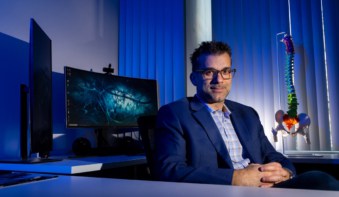
Stroke is the second leading cause of death worldwide and the third cause of induced disability, according to estimates from the Global Burden of Diseases, Injuries, and Risk Factors Study. Treatments based on constraint-induced movement therapy, occupational practice, virtual reality and brain stimulation can work well for patients with mild impairment of upper limb movement, but they are not as effective for those burdened by severe disability. Therefore, novel individualized approaches are needed for this patient group.
Martina Coscia from the Wyss Center for Bio and Neuroengineering in Geneva, and colleagues from several other Swiss institutes, have published a review paper summarizing the most advanced techniques in use today for treatment of severe, chronic stroke patients. The researchers describe techniques being developed for upper limb motor rehabilitation: from robotics and muscular electrical stimulation, to brain stimulation and brain–computer/machine interfaces (Brain 10.1093/brain/awz181).
Robot-aided rehabilitation approaches include movement-assisting exoskeletons and end-effector devices, which enable upper arm movement by stimulating the peripheral nervous system. These techniques can also trigger reorganization of the impaired peripheral nervous system and encourage rehabilitation of the damaged somatosensory system. Several studies have reported the efficiency of robot-aided rehabilitation, alone or in combination with other techniques, in the treatment of upper limb motor impairment. One study that included severely impaired individuals also demonstrated encouraging results.
Muscular electrical stimulation can help improve the connection of motor neurons to the spinal cord and the motor cortex. Researchers have also demonstrated that application of electrical stimuli to the muscles provides positive effects on the neurons responsible for sensory signal transduction to the brain, thereby improving the motion control loop function. By modulating motor neurons’ sensitivity, muscular electrical stimulation inhibits the muscle spasms observed in other treatments.
More recently, therapies have moved on from the simple use of currents to harnessing coordinated stimuli to orchestrate more complex, task-related movements. Although this particular set of techniques didn’t show a particular advantage over physiotherapy in long-term studies of patients with mild upper limb impairment, it did seem to have a stronger effect for chronic severe patients.
Stimulating the brain
Brain stimulation, meanwhile, stimulates cortical neurons in order to improve their ability to form new connections within the affected neural network. Brain stimulation techniques can be divided into two branches – electrical and magnetic – both of which can activate or inhibit neural activity, depending on the polarity and intensity of the stimulus.

Researchers have achieved encouraging results using both techniques. In particular, magnetic field-triggered inhibition of the contralesional hemisphere (the hemisphere that was not affected by the stroke) activity yielded positive results. Magnetic, low-frequency stimulation of the contralesional hemisphere also proved encouraging – improving the reach to grasp ability of patients, although only for small objects. Excitingly, some studies suggest that coupling contralesional cortex inhibition with magnetic stimulation of the chronically affected area could achieve effective results.
Within these techniques, one promising approach is invasive brain stimulation, in which a device is surgically implanted in a superficial region of the brain. Such techniques allow for more sustained and spatially-oriented stimulation of the desired brain regions. The Everest trial used such methods and showed significant improvement for a larger percentage of patients after 24 weeks, compared with standard rehabilitation protocols.
Another promising recent development is non-invasive deep-brain stimulation, achieved by temporally interfering electric fields. The authors envision that a deeper understanding of the complex mechanisms involved in the brain’s reactions to magnetic and electrical stimulation will provide an important assistance in clinical application of these techniques.
The final category, brain–computer or brain–machine interfaces (BCIs or BMIs), exploit electroencephalogram (EEG) patterns to trigger feedback or an action output from an external device. Devices that produce feedback are used to train the patient to recruit the correct zone of the brain and help reorganize its interconnections. These techniques have only recently transitioned to the clinic; however, early results and observations are promising. For example, a BCI technique coupled with muscular electrical stimulation restored patients’ ability to extend their fingers.
In recent years, researchers have also tested combinations of the techniques described above. For example, combinations of robotics and muscular electrical stimulation have shown encouraging results, especially when more than one articulation was targeted by the treatment. Combining brain stimulation with muscular electrical stimulation and robotics has proved more effective in severe than in moderate cases. Also, coupling of muscular electrical stimulation with magnetic inhibitory brain stimulation provided better results than either individual technique. Interestingly, addition of electrical brain stimulation to a BCI system coupled with a robotic motor feedback enhanced the outcome, helping to achieve adaptive brain remodelling at the expense of inappropriate reorganization.
Coscia and co-authors highlight that all the techniques studied share a range of limitations that should be addressed, such as small sample size, limited understanding of the underlying mechanisms, lack of treatment personalization and minimal attention to the training task, which they note is often of limited importance for daily life. Addressing these limitations might be key to improving the clinical outcome for patients with severe stroke-induced upper limb paralysis treated with neurotechnology-aided interventions. Moreover, the authors plan to begin a clinical trial to test the use of a novel personalized therapy approach that will include a combination of the described techniques.



